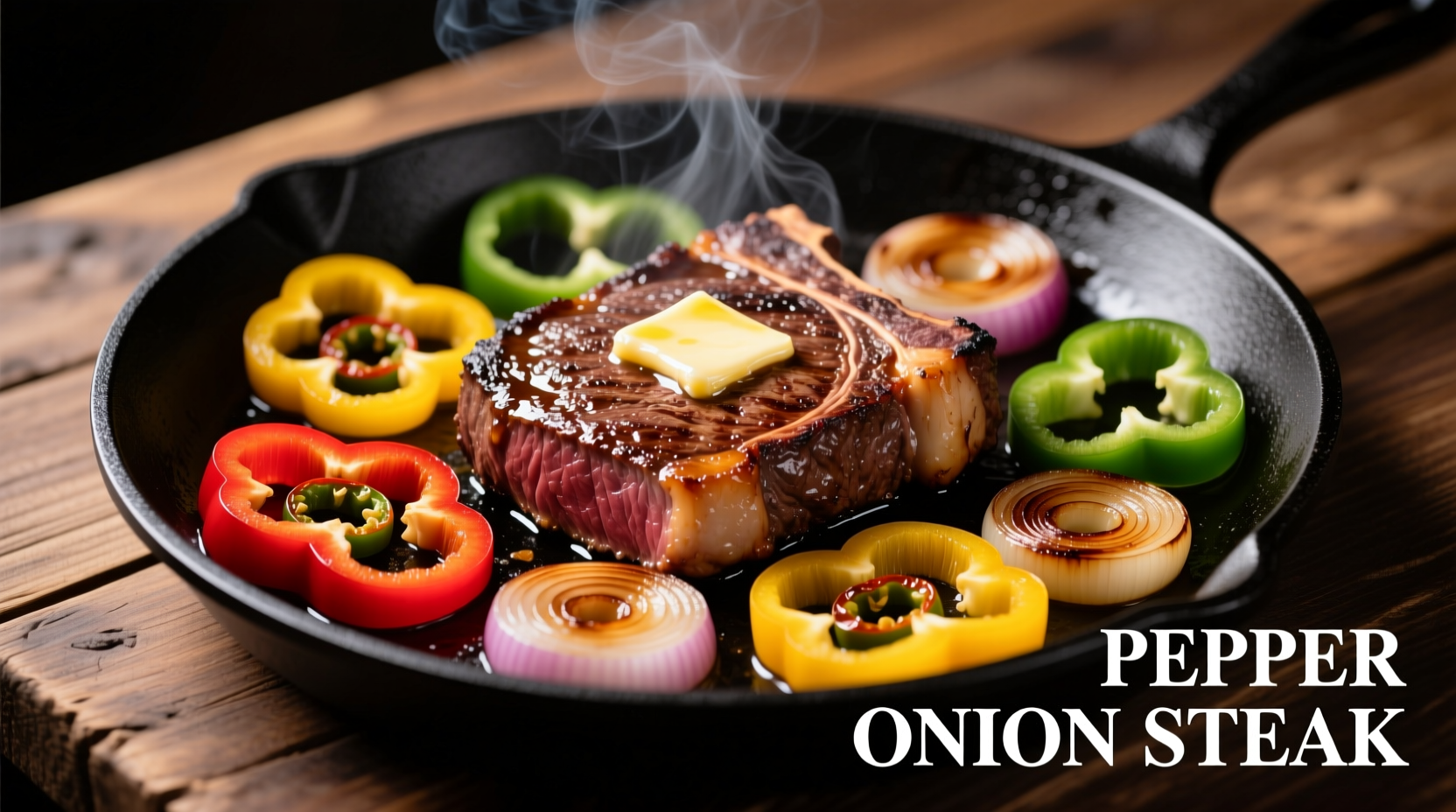Why Pepper Onion Steak Deserves a Place in Your Cooking Rotation
Pepper onion steak isn't just a simple weeknight dinner—it's a culinary masterpiece when executed properly. The combination of savory beef with sweet caramelized onions and slightly charred peppers creates a flavor profile that satisfies both comfort food cravings and gourmet expectations. Unlike many steak preparations, this dish transforms basic ingredients into something extraordinary through proper technique rather than expensive components.
Choosing Your Steak: The Foundation of Flavor
The cut you select dramatically impacts your final dish. While personal preference plays a role, certain cuts consistently deliver superior results for pepper onion steak preparation.
| Steak Cut | Best For | Cooking Time | Flavor Profile |
|---|---|---|---|
| Strip Steak | First-time cooks | 4-6 minutes per side | Rich beefy flavor with moderate marbling |
| Ribeye | Maximum flavor seekers | 5-7 minutes per side | Intensely marbled with complex fat flavors |
| Filet Mignon | Tender texture preference | 3-5 minutes per side | Milder flavor, exceptionally tender |
| Skirt Steak | Authentic fajita-style | 3-4 minutes per side | Robust beef flavor, requires proper slicing |
According to the USDA Food Safety and Inspection Service, steaks should reach a minimum internal temperature of 145°F (63°C) with a 3-minute rest period for medium-rare doneness. Using a reliable meat thermometer is essential for consistent results—USDA guidelines emphasize that visual cues alone aren't sufficient for determining safe cooking temperatures.
Pepper Selection: Beyond the Basic Bell
Not all peppers create the same flavor profile in your steak preparation. Understanding pepper varieties helps you customize your dish:
- Green bell peppers offer classic fajita flavor with moderate sweetness
- Red or yellow bell peppers provide enhanced sweetness and vibrant color
- Poblano peppers add mild heat with earthy notes (1,000-2,000 SHU)
- Jalapeños deliver noticeable heat (2,500-8,000 SHU) for spice lovers
Professional chefs recommend using a combination of pepper varieties for complexity. The key is maintaining consistent slice thickness—about 1/4 inch—to ensure even cooking. When preparing peppers for steak, always remove the seeds and white membranes for the most pleasant texture.
Onion Science: Achieving Perfect Caramelization
The transformation of raw onions into sweet, golden-brown perfection involves the Maillard reaction and caramelization—two distinct chemical processes that create complex flavors. This isn't just cooking; it's food science in action.
Yellow onions remain the gold standard for pepper onion steak due to their balanced sweetness and pungency. When sliced properly (about 1/4 inch thick), they develop rich umami compounds during cooking. The Texas A&M AgriLife Extension Service explains that onion preparation significantly impacts final flavor, with proper slicing technique affecting both texture and sweetness development.

Step-by-Step Cooking Process
Follow this professional sequence for optimal results:
Preparation Phase (15 minutes before cooking)
- Remove steak from refrigerator 30 minutes before cooking to bring to room temperature
- Dry the surface thoroughly with paper towels (critical for proper searing)
- Season generously with coarse salt and freshly ground black pepper
- Prepare vegetables: slice onions and peppers uniformly
Cooking Sequence
- Heat heavy skillet (cast iron preferred) over medium-high heat for 5 minutes
- Add high smoke-point oil (avocado or grapeseed) to the pan
- Sear steak 2-3 minutes per side until deep brown crust forms
- Remove steak and set aside to rest
- Reduce heat to medium, add onions and peppers to same pan
- Cook vegetables 8-10 minutes until caramelized but still slightly firm
- Return steak to pan for final 1-2 minutes to reheat
- Rest steak 5-7 minutes before slicing against the grain
Avoiding Common Pitfalls
Even experienced home cooks make these critical mistakes when preparing pepper onion steak:
- Overcrowding the pan—this steams rather than sears your ingredients
- Moving ingredients too frequently—prevents proper crust development
- Cutting too soon after cooking—causes precious juices to escape
- Using wet ingredients—water inhibits browning reactions
- Incorrect heat levels—too low prevents searing, too high burns exterior
Serving and Pairing Recommendations
For the complete pepper onion steak experience, consider these professional pairing suggestions:
- Classic presentation: Serve sliced steak over vegetables with a squeeze of fresh lime
- Carb accompaniments: Garlic mashed potatoes or cilantro-lime rice complement the flavors
- Sauces: A simple pan sauce made with deglazed fond enhances without overpowering
- Wine pairings: Medium-bodied reds like Malbec or Zinfandel balance the dish's richness
For authentic fajita-style presentation, serve sizzling on a cast iron platter—a technique popularized by Texas restaurants in the 1970s that continues to delight diners with its theatrical presentation and preserved heat.
Storage and Reheating Guidelines
When properly stored, cooked pepper onion steak maintains quality for 3-4 days in the refrigerator. The USDA FoodKeeper app recommends storing in airtight containers at or below 40°F (4°C). For best results when reheating:
- Slice steak before storing to ensure even reheating
- Reheat in a skillet over medium-low heat with a splash of broth
- Avoid microwave reheating which creates uneven texture
- Never reheat steak above 130°F (54°C) to prevent overcooking











 浙公网安备
33010002000092号
浙公网安备
33010002000092号 浙B2-20120091-4
浙B2-20120091-4